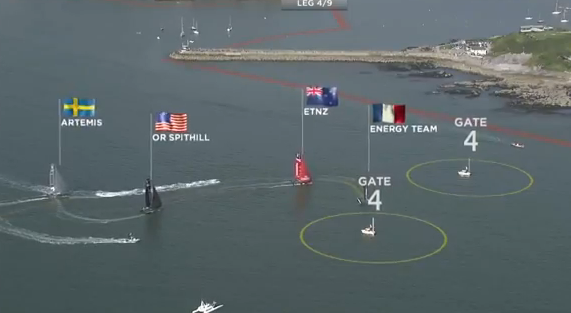How software on a par with guided missile systems are used for race animation
Technology being used by the America’s Cup World Series is leading the way in producing live graphics for sports. Stan Honey, the event’s director of technology, also a top navigator, has been explaning how custom built software and systems have revolutionised how boats’ position, course boundaries and penalties are calculated and displayed.
If you’ve watched any of the YouTube videos from the AC World Series, you’ll probably be familiar with the aerial views that place course boundaries and two boatlength circles round the marks right on the live camera pictures of the sailing – as shown in the photo above. This system is called Liveline.
How it’s achieved, and how it links with the penalty system being used here is very clever stuff indeed.
Each boat carries a box of tricks that sends and receives data from the race management system. Rather than using standard GPS, a much more accurate system called RTK (real time kinematics), which combines military and civilian signals, calculates the position of each boat to an accuracy of 2cm and the roll, pitch and yaw to 1/10th of a degree.
The key to calculating how close boats are to marks and overlaying the graphics is on a similar unit on a helicopter. This posed Honey and his colleagues a much harder challenge, because the helicopter is flying 1,500ft above the water but to avoid the graphic animations bobbing around the TV pictures the data coming from it has to be ultra accurate.
The difficulty was to measure the attitude of the helicopter accurately. A combination of RTK signal and an inertial measurement unit achieves this to 1/1,000th of a degree.
A knock-on problem is that systems akin to this are used to control guided missiles, and by International Treaty are subject to arms regulations control. So everywhere the AC World Series goes there’s discussion with government and detailed import and export paperwork to contend with.
“You need a permit to bring it in, and governments have been really helpful,” says Honey. “The main thing they are concerned with is that you don’t lose it.”
This system has some great uses for the race committee. The principal race officer can set the course boundaries and marks on a computer simply by clicking and dragging points on a polygon. “Once you hit the ‘commit’ button the information is sent to the mark boats and marshall boats and they get it immediately so it can all be set up very quickly,” says Honey.
It is so accurate that the system can also be used for determining boats that are OCS.
The speed and accuracy of adjusting a course also means the race committee can adjust the course length as the boats are racing by changing the distance sailed on the next leg.
Long races are 40 minutes’ duration and shorter races are 20 minutes and I noticed when I was a guest racer on Oracle 4 how accurate these times are. We finished in 41 minutes. It is very important for TV coverage that the races begin and end on schedule.
The race system has wind and performance information from the boats and can calculate how long it will take them to reach each mark, so the course can be stretched or shrunk as need be.
The same system is used for penalties. The AC World Series has its own penalty rules that involve boats slowing. At the time of a penalty an imaginary line appears two hull lengths behind the yacht at 90° to the course direction and this moves forward at 75% of the boat’s estimated VMG.
When that line catches up with the boat the penalty is complete. So the more a boat slows, the faster the penalty is discharged.
The aim of this is to keep boats in the game not stretch the fleet out. Multihulls are slow to tack and gybe, so penalty turns could put teams a long way behind.
The software calculates all that and data is sent back to the boat about when there’s a penalty and when it has been discharged, shown in lights and on a text display just in front of the helmsman.
The same text display shows metres to the course boundary, out of which crews must not stray, and a panel of lights flashes more quickly the nearer boats sail to the edge of the race course.
This software is proving to be useful in protest decisions. However, Mike Martin, director of umpires and rules administration, points out that this is still one area where individual judgement cannot be replaced.
“We’ve learned that some decisions are best made by a human being, such as whether a crew was doing all they could to keep clear, what’s happening with the sails, the blades or if the tiller is over. That is better seen on the water,” he says.
What’s interesting is that this level of technology is unique to sailing. Stan Honey has been involved in developing similar software and systems for other sports, such as baseball, football and motor sports, but he comments: “In sailing there is much more aggressive adoption and a very rapid interest in using the data as additional input for decisions.”

Stan Honey (left) and the Pelican case black box carried on every boat, and umpire and rules chief Mike Martin (right)




